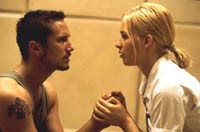If Tom Tykwer has a name in world cinema, it is largely due to his Lola rennt (Run, Lola, Run, 1998), a fast-moving, stylish and stylised story of Lola (Franka Potente), who has 45 minutes to save her boyfriend from the vengeful hands of a drug gang. Seemingly inspired by MTV as much as European traditions of cinema, Tykwer's uplifting tale of drugs, armed robberies and parental dysfunctionality struck a chord with audiences everywhere. So, at this year's Berlinale, his most recent film since Lola rennt, Der Krieger und die Kaiserin (The Warrior and the Princess, 2000), naturally drew considerable focus.
Psychiatric ward nurse Sissi (again played by Potente) seems so much a part of the ward she lives on, you could be forgiven for thinking she is one of the patients. At night she wanks off one of the patients and does not resist when others form attachments to her. This closeted life is broken apart when she receives a letter from an old friend asking her to do a simple favour: go to the bank and pick up an unknown something which the friend's recently departed mother has left her in her will.
Meanwhile, drifter Bodo is on the run after committing some unspecified crime. In a daring and dramatic escape, he jumps on to the back of an tanker. The driver, seeing the unwelcome hitcher, loses his attention on the road ahead and fails to prevent himself from running over an innocent pedestrian crossing the road, Sissi.
The stopped lorry actually makes a convenient place for Bodo to hide beneath in order to evade his pursuers, and while he is under there he makes use of his free time by performing a DIY tracheotomy with an army knife on Sissi to save her life (shown in gruesome detail).
Sissi goes on to make a full physical recovery, but she does not return to normal.  She becomes obsessed with the man who saved her life and seeks him out. Bodo, however, is still traumatised by the suicide of his wife, and is less than interested in Sissi, something compounded by the fact that he and his brother Walter are planning a bank robbery.
She becomes obsessed with the man who saved her life and seeks him out. Bodo, however, is still traumatised by the suicide of his wife, and is less than interested in Sissi, something compounded by the fact that he and his brother Walter are planning a bank robbery.
The pair's paths cross again when Sissi finally goes to the bank to accomplish her original mission at the same time that Bodo and Walter stage their robbery. What starts as a mission to simply save Walter from a gunshot wound turns into an inner voyage for the pair to come face to face with their own psychoses.
Heavy on the style
Der Krieger und die Kaiserin is a film shot at a very different pace than Lola rennt, and its running time comes in at around double that of its predecessor. Tykwer has not lost interest in the kind of effects that were the core building blocks of Lola rennt, but here they are blended more skillfully into the plot and the film feels far more like a film and less like the extended music video that Lola rennt came across as.
For those who want to, it is easy to heap scorn on what Tykwer does. His films can readily be dismissed as the triumph of style over content, his characters are obviously unbelievable and his appeal largely comes from the constant accumulation of effects, rather than plot or character development.
But for all these criticisms, which are not invalid, Tykwer is a very interesting and rewarding film-maker. The problem with Tykwer is that he simply doesn't want to play ball with traditional notions of auteur cinema and its opposition to Hollywood. For a long time now, art house cinema has been marked by a tendency to be suspicious of the medium it uses. Aware that the camera always lies, directors have often sought to achieve a kind of objectivity by employing long takes and avoiding montage, sometimes with such pomposity as to assume that this inherently implies a moral superiority.
Alternatively, they have used plot structure to question the the ability of any representation of a story to tell the truth. This sometimes involves showing the same action from different narrative perspectives (a technique which goes back to Akira Kurasawa's 1950 film Rashomon). A further method for avoiding a single point of view is portraying a large number of characters with only tangential links to each other, none of whom are central and all of whom revolve loosely around a certain theme or set of tangential events (an approach made famous by Robert Altman).
Tykwer is having none of that, however. He works from the starting point that film is a manipulative medium and doesn't feel any need to discuss this or to try and counteract with some sense of guilt as other directors do. The notion that film is not just a manipulative medium but should be one is, of course, not a new idea: in the 1920s Sergei Eisenstein was foremost in using the concept of montage and series of filmic tricks (what he called a "montage of attractions") as a means of manipulating the audience's emotions. Then such ideas were respectable. Now not so much.
A stunning example of this principle in action is the opening sequence, showing a simple and everyday activity: posting a letter. By using music and the camera, such a mundane process is elevated to a gripping and dramatic event in a way which underlines the importance of this seemingly innocent action to the plot. At many points, his montage of attractions is, when you think about them objectively, rather cheap and naive. But Tykwer carries them off with such flair and conviction that they are utterly compelling and drag you into the film.
Fairy tale characters
Tykwer also feels no compulsion to be bound by commonplace notions of reality. Without veering off totally into the realm of fantasy, he employs stylised characters who are contempoary archetypes rather than real character portraits. Their conversations and actions are not realistic in the traditional sense of the term, but rather isolate and caricature certain traits and emotions.
In this respect, Tykwer is harkening back to older methods of story-telling, and it is surely no coincidence that his title has the ring of a fairy tale to it. Whereas fairy tales would invariably depict wicked step-mothers, gothic castles and enchanted forests, Tykwer expresses himself through the archetypes of contempory society: road accidents, bank robberies and stand-offs with the police.
This conscious and deliberate stylisation also sets Tykwer apart from the
Hollywood ethos of film-making. No Hollywood director would be brave enough to strip a film down to its basic elements as completely as Tykwer does. And whilst Hollywood directors may love their special effects, they are usually used in singularly and in isolation to impress the eye. Tykwer's skill is to be able to link them together in such a way that they effect you emotionally.
As such, Tykwer is a rare thing in cinema for this day and age: a grand illusionist and a truly great manipulator of the medium and its ability to effect us as viewers. However, whether you like this approach or not depends on how far you are willing to suspend disbelief and let yourself be drawn into the film and also on how phased you are between Tykwer's use of more traditional story-telling techniques to explore highly contemporary themes.
Andrew James Horton, 7 May 2001
Moving on:




 She becomes obsessed with the man who saved her life and seeks him out. Bodo, however, is still traumatised by the suicide of his wife, and is less than interested in Sissi, something compounded by the fact that he and his brother Walter are planning a bank robbery.
She becomes obsessed with the man who saved her life and seeks him out. Bodo, however, is still traumatised by the suicide of his wife, and is less than interested in Sissi, something compounded by the fact that he and his brother Walter are planning a bank robbery.
